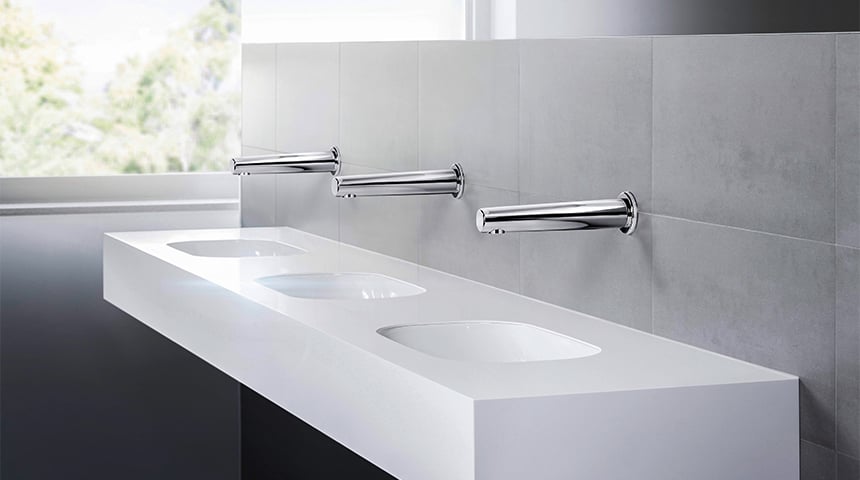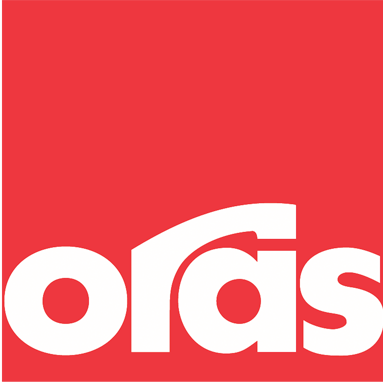Future airport bathrooms have to satisfy high standards of hygiene – even during the busiest holiday times. But they’re also expected to save time, resources and maintenance costs in the long run. Here’s how high-quality touchless faucets can deliver on that promise.

Handling large amounts of traffic each day, in the busy environment of airports, there’s no time for delays or malfunctions. And automatic faucets installed in airport bathrooms are no exception.
Whether your next project involves refurbishing an old airport, planning an additional terminal or designing a new airport building, hygiene and functional design must go hand in hand.
Here’s how smart bathroom technology can help ensure hassle-free operations, servicing and maintenance in the high-traffic environment of airports.
1. High-performing smart bathrooms for high-performing airports
Bathroom fittings in airports are expected to limit the spread of bacteria and other germs that result from multiple visitors touching the same surfaces every day. Meanwhile, they have to keep up with heavy use every day.
In the past years, automatically operated solutions, such as touchless faucets, have been the go-to measure for airport planners to help keep surfaces safe and bacteria-free. But they also fulfill another important function: keeping traffic flowing.
For the Oslo Airport in Norway, for example, touchless fixtures were already installed in 1998 and chosen again for its new terminal in 2017. With an estimated 24 million visitors every year and 1200 bathroom visits per hour during peak times, it’s key to ensure quality and durability in every bathroom fitting.
While touchless fixtures were a visionary move back in 1998, they are now a common feature in most modern airport buildings.
“We were early to market with touchless solutions, and we saw that there was a lot of fumbling among users at first. But now I think nobody wants to go back to using levers on faucets,” explains Works engineer Jon Henning Kristoffersen, responsible for site sanitation at Oslo Airport.
2. Maximise durability and minimise wear and tear
Simple and ergonomically designed electronic faucet models can further improve durability in high-traffic bathrooms. Their touchless operation and pre-mixed water setting help avoid wear and tear caused by frequent manual usage. A compact shape and pre-set flowtime also make them less prone to water spills, e.g. resulting from not closing levers correctly.
/Denmark/Blog/2021/References/Oras-Electra_6150F_6150FZ_6120FZ_6120FTZ_860x480.jpg?width=860&name=Oras-Electra_6150F_6150FZ_6120FZ_6120FTZ_860x480.jpg)
3. Offer simple and reliable servicing in highly complex buildings
Guaranteeing easy servicing of installed faucets is crucial, especially in highly complex buildings such as airports. When hosting multiple faucets that are connected to a central system, installers should be able to service a malfunctioning faucet without having to shut off the entire system.
Integrated features that are specifically designed for complex buildings, such as shut-off valves, are key to enabling building operators to remove, repair and replace a malfunctioning faucet without interrupting the flow of the remaining faucets in the building. At the same time, digital features that connect the faucet to an integrated app help access maintenance reports and adjust settings via the phone or tablet.
4. Reduce stagnation for a safe freshwater supply
Alongside intervals of high frequency, faucets must also be designed for low-traffic intervals or downtimes. This can impede water safety as stagnant waters in pipes and installations can easily lead to the growth of harmful bacteria, such as legionellae.
For example, water quality is already affected if a faucet is not used for more than 12 hours. That’s why conventional fixtures require manual flushing to keep installations clean and comply with regulations on drinking water hygiene.
Smart Bluetooth-enabled faucets with automatic flushing, such as the Oras Electra can effectively reduce time and costs spent on regular manual flushing. Due to a smart connection to the Oras App, building operators can pre-set automatic flushing intervals, guaranteeing regular flushing of the fixtures to provide fresh water to passengers at all times.
For the new Berlin Airport, which is set to become Germany’s busiest airport, automatic flushing was a key priority on the hygiene agenda.
“We needed to reduce stagnation in the drinking water network as much as possible, and it was important for the process to be automatic,” explains facility manager Eriko Werth.
As every airport’s operation and needs are different, flush times can be customised and adapted to the airport’s specifications.
In an industry that has no time for delays, smart faucets can save valuable time and money. Not only for visitors but also for building operators.
For your next project, make sure to plan for smart operation, optimal performance and easy maintenance from the start by choosing a faucet that is designed for durability, hygiene and advanced functionality.






/Denmark/Blog/2021/References/Oras-Electra_6150F_6150FZ_6120FZ_6120FTZ_860x480.jpg?width=860&name=Oras-Electra_6150F_6150FZ_6120FZ_6120FTZ_860x480.jpg)
